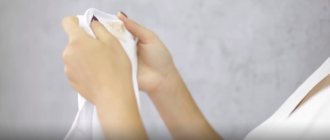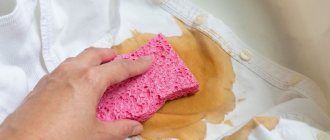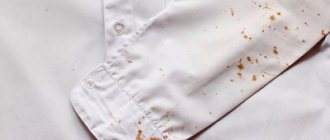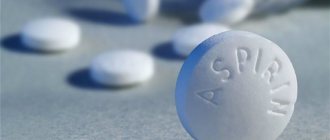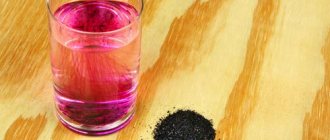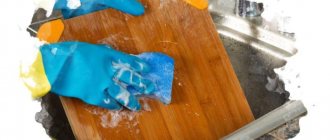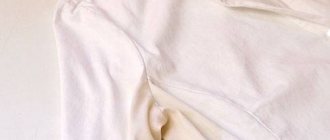How do you remove stains from clothes?
The main rule for removing any stain, which we all heard in advertisements for washing powder: we see stains on the outside, but the dirt eats into the fabric and is located inside. But no matter how much advertising praises branded stain removers, practice shows that they do not always cope with removing difficult stains. But in the fight against various stains, the decades-tested effect of some products that most housewives have in their homes is undeniable:
- salt and baking soda;
- juice from fresh lemon;
- ammonia;
- glycerol;
- laundry soap;
- denatured alcohol;
- gasoline or kerosene;
- potato starch;
- talc or chalk.
Separately, we should mention those substances, the use of which can have a detrimental effect on your clothes:
- acid and alcohol can cause harm by corroding the paint and leaving behind a white stain;
- bleach is fatal for cotton fabrics;
- vinegar and acetone can corrode silk;
- Alkaline-based bleaches are only suitable for removing stains from white fabrics.
Of course, before you start removing the stain, you need to determine which product “left” it. The method of eliminating it will depend on such diagnostics. Initially, you can try to remove the stain by treating it with a regular soap solution applied to a brush or sponge. Then, after washing off the solution and drying the stain, they evaluate the condition of the item, and if the stain is still noticeable, they begin to treat it with special substances.
“Golden” rules for eliminating any persistent pollution:
- It is better to treat stains from the inside of the item.
- To soften an old stain, blot it with glycerin.
- To prevent streaks from appearing, the fabric surrounding the stain is moistened with water or sprinkled with starch.
- The work to remove the stain is carried out with a brush, and you need to clean from the outlines of the stain to its center.
Refresh color and eliminate stains on colored fabrics
- Ingredients: 200 g grated laundry soap, 10 liters of water, 4 tablespoons of vegetable oil, vinegar for rinsing.
- Step-by-step instructions: prepare a soap solution in a saucepan with the addition of vegetable oil. Immerse colored laundry that does not fade in the solution and bring to a boil. Keep on fire for about 5 minutes. After the items have cooled, take them out and wash them by hand or in a washing machine, and add a little vinegar during the last rinse.
How to remove grease stains from colored clothes at home?
It just so happens that grease stains on clothes are, alas, the most common. But there is good news: there are many ways to breed them, so to speak, for every taste. We will introduce you to the main methods for eliminating them from colored clothing:
- a greasy stain of “first freshness” (from different types of oils, mayonnaise, etc.) can be neutralized by rubbing good washing powder into it and washing at elevated temperatures;
- fresh fat with bread or using table salt, and then wash as in the previous paragraph; with this method, salt must be replaced 4-5 times;
- chalk and talc - help in the fight against recent stains from light-colored clothing; rub the powder into the stain and leave for 2-3 hours, and then carry out normal cleaning;
- Apply chalk dissolved in gasoline to an old greasy stain and thoroughly rub the mixture into the fabric, and after 3 hours wash at high temperature;
- if a large area of tissue has been damaged by fat, soak it in turpentine, and then carry out appropriate treatment;
- fatty traces on colored, bright fabrics “give up” to a mixture of glycerin and laundry soap; to obtain a porridge-like consistency, add water to the mass, leave for 20-24 hours, and then rinse well;
- the grease stain recedes before potato flour or potato pulp mixed with gasoline, which is generously applied to the fabric;
- The greasy stain is generously sprinkled with baby powder, covered with a blotter and the fabric is gently ironed.
What to do if your clothes have suffered from offensive greasy stains left by canned fish? Simply wipe the stain with a swab soaked in kerosene, and then do a normal wash.
The area of fabric affected by the grease stain is placed on a board covered with a plain white cloth or absorbent paper. During the stain removal process, the stain will be imprinted onto this substrate.
Tip: stains from machine oil, as well as from regular vegetable oil, can be removed by rubbing a drop of dishwashing detergent into the fabric and then washing the item as usual.
Sweat stains on white clothes: how to remove?
Such stains differ from other types of stains in their “rich” composition. They contain sulfates and phosphates, fats, salts, organic elements, urea and other substances, which damage some types of fabrics, such as wool and silk, and corrode dyes. Removing sweat stains is done as follows:
- a hyposulfite solution (5 ml per 250 ml of water) is rubbed into the fabric, after which the clothes are washed in warm water;
- use a swab dipped in a concentrated salt solution to go over sweat stains on fabric containing more than 50% wool fibers; this method is also effective against the characteristic odor of sweat, which often penetrates into the fabric;
- simply treating the fabric with alcohol often helps quickly remove sweat stains;
- technical ethyl alcohol and ammonia are mixed in equal parts and with this composition they get rid of stains from lining or other “capricious” fabric;
- When washing items damaged by sweat stains, add ammonia to the water.
Tough stains
If untidy marks on clothes are discovered late, it will be much more difficult to wash them and you will have to put in more effort. Such contaminants are called difficult to remove. Sometimes you have to use strong bleaches to eliminate them, and in some cases only proven folk remedies help, because you don’t want to throw away your favorite things.
There are several types of stains that are very difficult to wash off. This category includes stains from:
- sweat;
- food;
- herbs;
- cosmetics;
- paints;
- blood.
Difficult to remove food stains can be divided into several categories. These are untidy blots from vegetables or fruits, drinks, fatty meat dishes. This also includes any derivative products:
- coffee;
- wine;
- sauce;
- jam;
- ketchup;
- jam;
- juice.
Food stains are easily removed at the very beginning. The more time passes from the moment they appear, the more difficult it will be to clean things up. Before choosing a method to eliminate the problem, you need to determine the type of fabric, the type of stain and the period during which the stains remained on the clothing. After studying the product label, it will be clear what types of processing are acceptable.
- 3 legal ways to avoid paying commissions for Sberbank transfers
- Terbinafine spray
- New pension payment options to get all your pension savings at once
How to remove a ballpoint pen stain from clothes?
Contrary to popular belief that ink stains are difficult to remove, they can be easily removed. Here are some simple, proven ways to add to your piggy bank:
- the area with the ink mark is covered with glycerin for 40-60 minutes, after which the item is washed with soap;
- sour milk is a well-known fighter against marks from a ballpoint pen; just dip the smeared area of fabric in heated milk, which is beginning to sour, for a couple of hours, and then wash the item with soap, dropping a little ammonia into it;
- if white fabric is smeared with ink, use ammonia diluted with peroxide; after - a normal wash is performed;
- turpentine and technical alcohol, if you take the same amount of them, cope well with ink stains;
- if the stain is located on colored fabric, it is removed with a composition of glycerin and technical alcohol;
- A fresh mark from a ballpoint pen can easily come off if you cover it with salt and pour plenty of fresh lemon juice on it.
Tip: before removing ballpoint pen marks from fabric, rinse the stained area with water to slightly dilute the pigment. If the stain is fresh, then you can remove it with regular washing powder or soap, after wiping it with ammonia.
Whitening fabric by simply boiling
Before bleaching white fabric using these methods, you will need to prepare suitable containers and equipment. These can be wooden tongs or a perfectly smooth stick.
For boiling, it is advisable to prepare a large stainless steel pan (as a last resort, you can choose an enamel bucket, but always with a lid). Please note: The selected containers should not have any traces of rust on the inside, which may settle on the laundry when boiled.
The procedure for carrying out this procedure looks like this:
- First, clean water is poured into the selected dish to fill two-thirds of its capacity, after which it is placed on a gas stove with a medium heating level.
- As soon as the water is heated to a state that allows washing powder to be dissolved in it, the laundry is placed in it.
- When laying it, you need to make sure that the container is not overloaded (if the volume of things is small, they will be less “cooked” and will turn out cleaner).
- Then you need to close the container with a lid and continuously monitor it until the water boils.
- With the container closed, wait until foam appears and carefully stir the laundry with a stick so that it does not stick to the hot walls and bottom.
After a minute or two, you can reduce the gas and continue boiling, stirring the contents of the pan. The duration of this procedure depends on the degree of contamination of white items and the quality of the fabric.
How to remove paint stains from clothes?
How many elements of our wardrobe have been damaged as a result of interaction with such a treacherous substance as oil paint! All you have to do is sit down on a painted, not completely dry bench in the park - and you are guaranteed to get an annoying, difficult-to-remove stain on your favorite jeans or jacket. But not everything is so hopeless; even paint stains can be removed without any problems. This can be done successfully:
- wiping off the dirt with a cotton swab coated with kerosene;
- if the stain does not go away, continue treating with ammonia until the stain is completely eliminated;
- a mixture of gasoline soap and turpentine in equal parts, rubbing the mixture into the stain, after which the composition must be washed off and the item washed as usual;
- by cleaning the fabric with a concentrated soda solution after pre-treating the stain with turpentine;
- Lubricate the paint stain with butter to soften it a little, then treat it with gasoline.
Tip: a fresh “colorful” stain can be removed by generously treating it with a soapy detergent solution and leaving the item for an hour or two. The detergent will slightly soften and corrode the paint, which will allow you to easily remove it through normal washing.
Removing traces of stubborn stains from baby clothes, diapers, reusable diapers
- Ingredients: a bar of laundry soap, grated on a fine grater, 70 g of soda, 5 liters of water.
- Step-by-step instructions: mix the ingredients for boiling in a large container, cover the bottom with an old, clean rag. Then place the contaminated children's things there. Bring to a boil, keep on low heat for 20 minutes, occasionally stirring the laundry with wooden tongs. Then cool the laundry in the same solution, then rinse and dry twice.
How to remove blood stains?
They say that removing blood stains is as easy as shelling pears, since fresh blood is washed off even with cold water. And yet, blood is a complex substance; it contains amino acids, fats and coloring substances. Therefore, exposure to water alone is not enough to remove blood stains. But what to do if the stain is several days old, or maybe even weeks old? Here are effective methods:
- the easiest way is long soaking, after which the item is washed in warm soapy water;
- an old stain will be removed faster after wiping it with a solution of borax or ammonia;
- Blood can be removed from thin tissues using dried starch paste;
- clothes “decorated” with old blood stains are left in salt water for a couple of hours, after which they are actually washed;
- Hydrogen peroxide helps remove blood from white tissue.
Drink marks
Spilled white wine or light juice will also leave a yellow coating on your outfit. Residues of juice and wine on clothing items are of the same nature, and therefore are also removed in the same way. A simple means of displaying a fruit signature on white is ordinary table salt.
The method is good if the contamination is fresh. The dirty area is simply sprinkled with table salt, left for half an hour, and then washed along with other things.
To answer the question of how to whiten yellow stains on things left after spilled wine or juice, let's turn to old recipes. In the old days, ammonia was used for bleaching. First you just need to moisten the stain with alcohol, and when the dried juice gets wet, rub it with a damp cloth. Subsequently, the item is rinsed under running water and dried.
The fruit mark on a white cotton shirt is removed the old fashioned way. The product is pulled over the hole of the dish and boiling water is poured onto the dirty area until the motley smear dissolves.
Coffee, tea and red wine stains: remove at home
The difficulty in removing coffee stains is that in addition to dyes, they often also contain proteins and tannins.
Marks from coffee or tea are wiped with diluted ammonia or concentrated saline solution using a stiff brush. As for old stains, hydrogen peroxide : just hold the stain in it for 10-15 minutes, then rinse thoroughly in cool water.
Coffee and tea stains will go away if you treat the item with a soap solution also containing ½ teaspoon of soda and 1 teaspoon of ammonia (proportions are given for 1-1.5 liters of water). After this procedure, you need to rinse the clothes in water at a temperature of 20-22°C, adding a little vinegar to it.
Warm glycerin will help remove coffee stains from light or colored fabrics . The stained area is lubricated with the substance, and then normal washing is carried out. Provided that the stain is complex and long-standing, ammonia .
A slurry of washing powder helps to remove coffee stains from white fabrics , carefully rubbed into the area of the fabric with the stain. After this procedure, you need to additionally treat the stain with diluted bleach .
The algorithm for removing red wine stains is similar to removing “marks” from berries and their juices.
- Try to get rid of them using regular boiling water, if the type of fabric allows this. Place the damaged item over the sink or pan, allowing access to the stain. Pour hot water onto the stain from a height of 30-50 cm, repeating this action until the wine stain completely disappears.
- Colored fabrics will be cleared of wine stains after treating the stain with a mixture of glycerin and egg yolk (raw).
- Using salt diluted with water to a mushy consistency will help. After treatment, rinse the fabric with warm water and a cleanser.
- It is effective to use a solution of potassium permanganate, which is used to wet the contaminated area. After a couple of minutes, the product is washed off, and the fabric is treated with peroxide diluted in water.
Returning whiteness to fabrics yellowed from long-term storage
- Ingredients: 100 g of soap shavings, several crystals of potassium permanganate, 6 liters of water.
- Step-by-step instructions: stir soap shavings and potassium permanganate in warm water until completely dissolved. In a container suitable for boiling, combine linen made from white natural fabrics with a bleaching solution. Straighten the laundry without compacting it. Put on fire and wait for it to boil. Reduce heat and simmer, stirring, for about half an hour. Allow the laundry to cool in the solution. Then remove the laundry and rinse thoroughly.
How do you remove stains from outerwear?
Even on outer clothing you can get stains that are difficult to remove; all you have to do is lean against something or sit on a painted bench.
But even such a problem can be successfully overcome if you know the little secrets that we will share with you. What to do if you manage to put a stain (greasy or ink) on a leather item? In this case, the same glycerin, diluted with technical alcohol , which is rubbed into the stain, will help. If a barely noticeable trace remains, the item can be tinted. Oily stains on fair skin can be easily removed with lemon juice.
Also, ink stains can be easily removed with salt: you need to cover the leather clothing in the area where it is contaminated with a generous layer of wet salt and wait a couple of days. After this, the salt is removed, and the item is wiped with a sponge dipped in turpentine.
A special category of “difficult” stains are grease stains on down jackets and bologna jackets, which cannot be removed with normal washing. We suggest you try the following options.
And finally, a few more useful tips for all occasions on how to get rid of different types of stains of all degrees of complexity.
Cleaning and bleaching kitchenware
- Ingredients: 200 g of soda ash, 150 g of transparent office glue, 100 g of crushed laundry soap, 20 liters of water.
- Step-by-step instructions: mix all ingredients in a 30-liter boiling container. Bring the solution to a hot state, while closing the door to the kitchen and turning on the hood or opening the window. Dip dirty dishes into the hot mixture and simmer for 15-30 minutes. After this, leave the dishes to cool in this solution. If after a while it is clear that not all the dirt has come off, repeat the procedure the next day using the same solution. Finally, rinse the dishes under running water.
